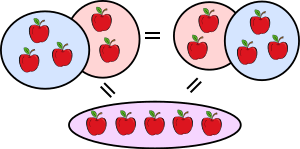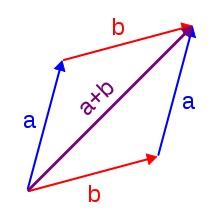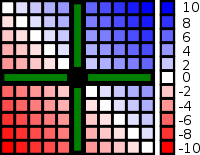Commutative property
In mathematics, a binary operation is commutative if changing the order of the operands does not change the result. It is a fundamental property of many binary operations, and many mathematical proofs depend on it. Most familiar as the name of the property that says "3 + 4 = 4 + 3" or "2 × 5 = 5 × 2", the property can also be used in more advanced settings. The name is needed because there are operations, such as division and subtraction, that do not have it (for example, "3 − 5 ≠ 5 − 3"); such operations are not commutative, and so are referred to as noncommutative operations. The idea that simple operations, such as the multiplication and addition of numbers, are commutative was for many years implicitly assumed. Thus, this property was not named until the 19th century, when mathematics started to become formalized.[1][2] A corresponding property exists for binary relations; a binary relation is said to be symmetric if the relation applies regardless of the order of its operands; for example, equality is symmetric as two equal mathematical objects are equal regardless of their order.[3]
.svg.png)
Common uses
The commutative property (or commutative law) is a property generally associated with binary operations and functions. If the commutative property holds for a pair of elements under a certain binary operation then the two elements are said to commute under that operation.
Mathematical definitions
The term "commutative" is used in several related senses.[4][5]
- A binary operation on a set S is called commutative if:
- One says that x commutes with y under if:
- A binary function is called commutative if:
Examples
Commutative operations in everyday life

- Putting on socks resembles a commutative operation since which sock is put on first is unimportant. Either way, the result (having both socks on), is the same. In contrast, putting on underwear and trousers is not commutative.
- The commutativity of addition is observed when paying for an item with cash. Regardless of the order the bills are handed over in, they always give the same total.
Commutative operations in mathematics

Two well-known examples of commutative binary operations:[4]
- The addition of real numbers is commutative, since
- For example 4 + 5 = 5 + 4, since both expressions equal 9.
- The multiplication of real numbers is commutative, since
- For example, 3 × 5 = 5 × 3, since both expressions equal 15.
- As a direct consequence of this, it also holds true that expressions on the form y% of z and y% of z% are commutative for all real numbers y and z.[6] For example 64% of 50 = 50% of 64, since both expressions equal 32, and 30% of 50% = 50% of 30%, since both of those expressions equal 15%.
- Some binary truth functions are also commutative, since the truth tables for the functions are the same when one changes the order of the operands.
- For example, the logical biconditional function p ↔ q is equivalent to q ↔ p. This function is also written as p IFF q, or as p ≡ q, or as Epq.
- The last form is an example of the most concise notation in the article on truth functions, which lists the sixteen possible binary truth functions of which eight are commutative: Vpq = Vqp; Apq (OR) = Aqp; Dpq (NAND) = Dqp; Epq (IFF) = Eqp; Jpq = Jqp; Kpq (AND) = Kqp; Xpq (NOR) = Xqp; Opq = Oqp.
- Further examples of commutative binary operations include addition and multiplication of complex numbers, addition and scalar multiplication of vectors, and intersection and union of sets.
Noncommutative operations in daily life
- Concatenation, the act of joining character strings together, is a noncommutative operation. For example,
- EA + T = EAT ≠ TEA = T + EA
- Washing and drying clothes resembles a noncommutative operation; washing and then drying produces a markedly different result to drying and then washing.
- Rotating a book 90° around a vertical axis then 90° around a horizontal axis produces a different orientation than when the rotations are performed in the opposite order.
- The twists of the Rubik's Cube are noncommutative. This can be studied using group theory.
- Thought processes are noncommutative: A person asked a question (A) and then a question (B) may give different answers to each question than a person asked first (B) and then (A), because asking a question may change the person's state of mind.
- The act of dressing is either commutative or non-commutative, depending on the items. Putting on underwear and normal clothing is noncommutative. Putting on left and right socks is commutative.
- Shuffling a deck of cards is non-commutative. Given two ways, A and B, of shuffling a deck of cards, doing A first and then B is in general not the same as doing B first and then A.
Noncommutative operations in mathematics
Some noncommutative binary operations:[7]
Division and subtraction
Division is noncommutative, since .
Subtraction is noncommutative, since . However it is classified more precisely as anti-commutative, since .
Truth functions
Some truth functions are noncommutative, since the truth tables for the functions are different when one changes the order of the operands. For example, the truth tables for (A ⇒ B) = (¬A ∨ B) and (B ⇒ A) = (A ∨ ¬B) are
A B A ⇒ B B ⇒ A F F T T F T T F T F F T T T T T
Function composition of linear functions
Function composition of linear functions from the real numbers to the real numbers is almost always noncommutative. For example, let and . Then
and
This also applies more generally for linear and affine transformations from a vector space to itself (see below for the Matrix representation).
Matrix multiplication
Matrix multiplication of square matrices is almost always noncommutative, for example:
Vector product
The vector product (or cross product) of two vectors in three dimensions is anti-commutative; i.e., b × a = −(a × b).
History and etymology
Records of the implicit use of the commutative property go back to ancient times. The Egyptians used the commutative property of multiplication to simplify computing products.[8][9] Euclid is known to have assumed the commutative property of multiplication in his book Elements.[10] Formal uses of the commutative property arose in the late 18th and early 19th centuries, when mathematicians began to work on a theory of functions. Today the commutative property is a well-known and basic property used in most branches of mathematics.
The first recorded use of the term commutative was in a memoir by François Servois in 1814,[1][11] which used the word commutatives when describing functions that have what is now called the commutative property. The word is a combination of the French word commuter meaning "to substitute or switch" and the suffix -ative meaning "tending to" so the word literally means "tending to substitute or switch." The term then appeared in English in 1838[2] in Duncan Farquharson Gregory's article entitled "On the real nature of symbolical algebra" published in 1840 in the Transactions of the Royal Society of Edinburgh.[12]
Propositional logic
| Transformation rules |
|---|
| Propositional calculus |
| Rules of inference |
| Rules of replacement |
| Predicate logic |
Rule of replacement
In truth-functional propositional logic, commutation,[13][14] or commutativity[15] refer to two valid rules of replacement. The rules allow one to transpose propositional variables within logical expressions in logical proofs. The rules are:
and
where "" is a metalogical symbol representing "can be replaced in a proof with."
Truth functional connectives
Commutativity is a property of some logical connectives of truth functional propositional logic. The following logical equivalences demonstrate that commutativity is a property of particular connectives. The following are truth-functional tautologies.
- Commutativity of conjunction
- Commutativity of disjunction
- Commutativity of implication (also called the law of permutation)
- Commutativity of equivalence (also called the complete commutative law of equivalence)
Set theory
In group and set theory, many algebraic structures are called commutative when certain operands satisfy the commutative property. In higher branches of mathematics, such as analysis and linear algebra the commutativity of well-known operations (such as addition and multiplication on real and complex numbers) is often used (or implicitly assumed) in proofs.[16][17][18]
Mathematical structures and commutativity
- A commutative semigroup is a set endowed with a total, associative and commutative operation.
- If the operation additionally has an identity element, we have a commutative monoid
- An abelian group, or commutative group is a group whose group operation is commutative.[17]
- A commutative ring is a ring whose multiplication is commutative. (Addition in a ring is always commutative.)[19]
- In a field both addition and multiplication are commutative.[20]
Related properties
Associativity
The associative property is closely related to the commutative property. The associative property of an expression containing two or more occurrences of the same operator states that the order operations are performed in does not affect the final result, as long as the order of terms doesn't change. In contrast, the commutative property states that the order of the terms does not affect the final result.
Most commutative operations encountered in practice are also associative. However, commutativity does not imply associativity. A counterexample is the function
which is clearly commutative (interchanging x and y does not affect the result), but it is not associative (since, for example, but ). More such examples may be found in commutative non-associative magmas.
Distributive
Symmetry

Some forms of symmetry can be directly linked to commutativity. When a commutative operator is written as a binary function then the resulting function is symmetric across the line y = x. As an example, if we let a function f represent addition (a commutative operation) so that f(x,y) = x + y then f is a symmetric function, which can be seen in the adjacent image.
For relations, a symmetric relation is analogous to a commutative operation, in that if a relation R is symmetric, then .
Non-commuting operators in quantum mechanics
In quantum mechanics as formulated by Schrödinger, physical variables are represented by linear operators such as x (meaning multiply by x), and . These two operators do not commute as may be seen by considering the effect of their compositions and (also called products of operators) on a one-dimensional wave function :
According to the uncertainty principle of Heisenberg, if the two operators representing a pair of variables do not commute, then that pair of variables are mutually complementary, which means they cannot be simultaneously measured or known precisely. For example, the position and the linear momentum in the x-direction of a particle are represented by the operators and , respectively (where is the reduced Planck constant). This is the same example except for the constant , so again the operators do not commute and the physical meaning is that the position and linear momentum in a given direction are complementary.
See also
| Look up commutative property in Wiktionary, the free dictionary. |
- Anticommutative property
- Centralizer and normalizer (also called a commutant)
- Commutative diagram
- Commutative (neurophysiology)
- Commutator
- Parallelogram law
- Particle statistics (for commutativity in physics)
- Quasi-commutative property
- Trace monoid
- Commuting probability
Notes
- Cabillón and Miller, Commutative and Distributive
- Flood, Raymond; Rice, Adrian; Wilson, Robin, eds. (2011). Mathematics in Victorian Britain. Oxford University Press. p. 4.
- Weisstein, Eric W. "Symmetric Relation". MathWorld.
- Krowne, p.1
- Weisstein, Commute, p.1
- "Compatible Numbers to Simplify Percent Problems". Retrieved 17 July 2020.
- Yark, p.1.
- Lumpkin, p.11
- Gay and Shute, p.?
- O'Conner and Robertson, Real Numbers
- O'Conner and Robertson, Servois
- D. F. Gregory (1840). "On the real nature of symbolical algebra". Transactions of the Royal Society of Edinburgh. 14: 208–216.
- Moore and Parker
- Copi, Irving M.; Cohen, Carl (2005). Introduction to Logic. Prentice Hall.
- Hurley, Patrick (1991). A Concise Introduction to Logic 4th edition. Wadsworth Publishing.
- Axler, p.2
- Gallian, p.34
- p. 26,87
- Gallian p.236
- Gallian p.250
References
Books
- Axler, Sheldon (1997). Linear Algebra Done Right, 2e. Springer. ISBN 0-387-98258-2.
- Abstract algebra theory. Covers commutativity in that context. Uses property throughout book.
- Copi, Irving M.; Cohen, Carl (2005). Introduction to Logic. Prentice Hall.CS1 maint: ref=harv (link)
- Gallian, Joseph (2006). Contemporary Abstract Algebra, 6e. Boston, Mass.: Houghton Mifflin. ISBN 0-618-51471-6.
- Linear algebra theory. Explains commutativity in chapter 1, uses it throughout.
- Goodman, Frederick (2003). Algebra: Abstract and Concrete, Stressing Symmetry, 2e. Prentice Hall. ISBN 0-13-067342-0.
- Abstract algebra theory. Uses commutativity property throughout book.
- Hurley, Patrick (1991). A Concise Introduction to Logic 4th edition. Wadsworth Publishing.
Articles
- https://web.archive.org/web/20070713072942/http://www.ethnomath.org/resources/lumpkin1997.pdf Lumpkin, B. (1997). The Mathematical Legacy Of Ancient Egypt - A Response To Robert Palter. Unpublished manuscript.
- Article describing the mathematical ability of ancient civilizations.
- Robins, R. Gay, and Charles C. D. Shute. 1987. The Rhind Mathematical Papyrus: An Ancient Egyptian Text. London: British Museum Publications Limited. ISBN 0-7141-0944-4
- Translation and interpretation of the Rhind Mathematical Papyrus.
Online resources
- "Commutativity", Encyclopedia of Mathematics, EMS Press, 2001 [1994]
- Krowne, Aaron, Commutative at PlanetMath.org., Accessed 8 August 2007.
- Definition of commutativity and examples of commutative operations
- Weisstein, Eric W. "Commute". MathWorld., Accessed 8 August 2007.
- Explanation of the term commute
- Yark. Examples of non-commutative operations at PlanetMath.org., Accessed 8 August 2007
- Examples proving some noncommutative operations
- O'Conner, J J and Robertson, E F. MacTutor history of real numbers, Accessed 8 August 2007
- Article giving the history of the real numbers
- Cabillón, Julio and Miller, Jeff. Earliest Known Uses Of Mathematical Terms, Accessed 22 November 2008
- Page covering the earliest uses of mathematical terms
- O'Conner, J J and Robertson, E F. MacTutor biography of François Servois, Accessed 8 August 2007
- Biography of Francois Servois, who first used the term